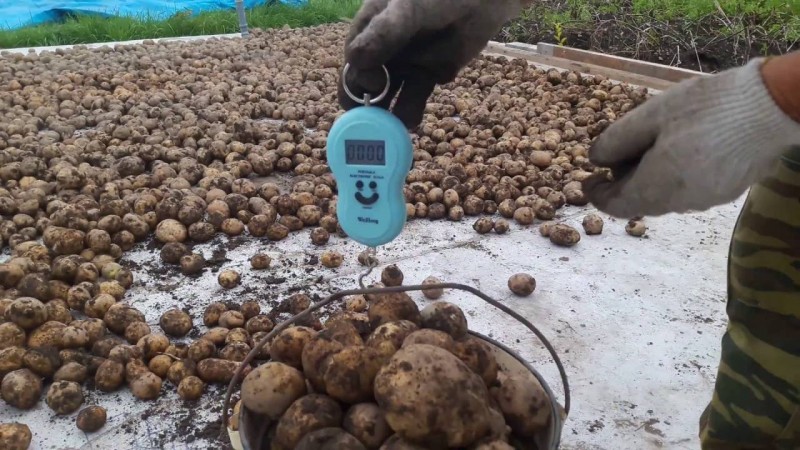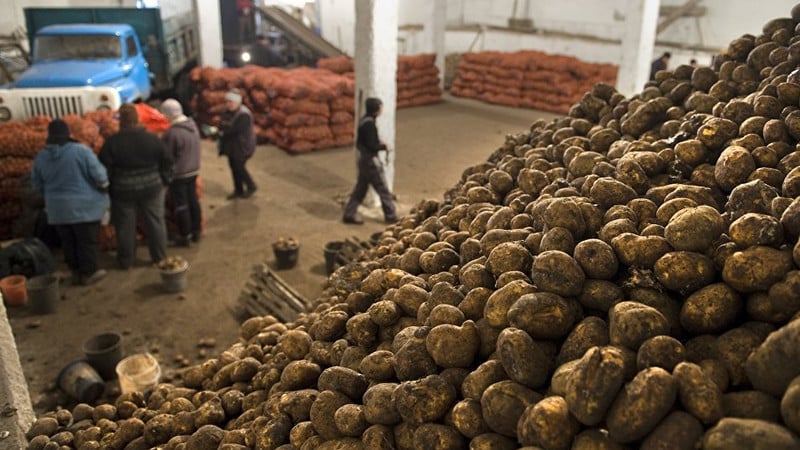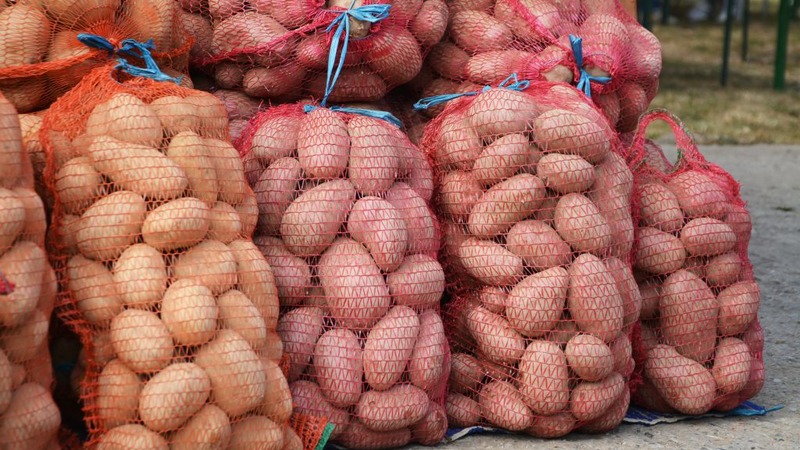What is the potato yield per 1 hectare and how to increase it
Potatoes are one of the most common crops. It is used in cooking, for fattening livestock, and obtaining technical raw materials. And therefore, potato yield is one of its most important characteristics. We'll tell you what it depends on and whether it can be increased.
What is the potato yield per 1 hectare?
First, let's determine what the average potato yield is.
Average figures in Russia

For Russia, the norm is considered to be a yield of approximately 150-200 c/ha. However, these are extremely average data. Depending on the variety, climatic conditions in the region, and soil composition, indicators can vary greatly.
We are talking about industrial cultivation with inevitable losses and reduced labor intensity of operations for economic reasons. How many potatoes can you harvest from a regular garden plot? Gardeners who spare no effort sometimes get a harvest on their acres that, calculated per hectare, amounts to 600-650 c/ha.
In other countries
The average potato yield by country is approximately:
- in the USA and New Zealand - 490 c/ha;
- in Germany and Denmark – 440 c/ha;
- in Holland – 420 c/ha;
- in Australia – 400-404 c/ha.
Leaders in the post-Soviet space:
- Uzbekistan – 225 c/ha;
- Latvia – 213 c/ha;
- Armenia – 211 c/ha;
- Turkmenistan – 206 c/ha.
However, there are countries where the yield is much lower than in Russia. For example, among the post-Soviet countries, Moldova is one of them - on average, they manage to grow only 104 c/ha. In non-CIS countries, the “failing students” in growing potatoes are:
- China – 170 c/ha;
- Canada – 126 c/ha;
- Tanzania – 81 c/ha;
- Bolivia – 60 c/ha;
- Nigeria – 38 c/ha.
However, low yield does not mean low production. For example, although China is inferior to Russia in terms of the number of potatoes per hectare, it confidently holds about 25% of the world production of this crop.
Record figures

The absolute record for potato yield during large-scale cultivation in Europe was recorded in 2011 in Belgium. There this figure was 501 c/ha. The world record was recorded in 2010 in New Zealand: there, several farms managed to achieve a yield of 880 c/ha. As of 2019, this record has yet to be broken.
What does it depend on?
What factors influence potato yield?
Planting material
For any crop, the quality and quantity of the harvest depends on the seeds, and in the case of potatoes, on the tubers. When planting potatoes, the following points regarding seed material must be taken into account:
- Variety Breeders have already developed about 8 thousand varieties of potatoes. Many of them are capable of producing very high yields.
- Seed quality. In cases where part of the harvest is used for sowing, sooner or later the potatoes degenerate and the yield falls. For record yields, tubers of no more than the third reproduction should be used.
Compliance with crop rotation rules
Getting a good harvest is unthinkable without observing crop rotation. When growing “potatoes by potatoes,” in just 3-4 years the soil will be depleted and yields will drop to a minimum.
For industrial cultivation, the following crop rotation scheme is usually used:
- Steam.
- Winter rye.
- Potato.
- Wheat.
- Green mass (oats plus vetch) for two harvests.
- Oats for grain.
In the simplest case, it is necessary to interrupt the potato planting cycles with green manure: hairy vetch, white mustard, winter rye, oilseed radish, etc.
When growing on a personal plot, it is important to ensure that the predecessors of potatoes are:
- cabbage;
- cucumbers;
- pumpkin and other melons;
- onion or garlic;
- legumes (peas, beans, etc.);
- celery;
- spinach.
Acceptable crops:
- beet;
- carrot;
- coriander and other spicy herbs;
- radish;
- turnip.
Inadmissible predecessors are potatoes themselves and their relatives (tomatoes, peppers, eggplants), as well as strawberries.
Proper care

High potato yields are achieved with proper care. It includes the following measures:
- Regular weeding.
- Hilling up at least 2-3 times per season.
- Water at least once a week, except during rainy periods.
- Pest control and treatment of seedlings with chemicals.
- Top dressing (both pre-winter and spring), as well as summer feeding during the period of tuber growth.
Soil quality
Potatoes love loose, well-aerated soil.. It is unlikely that high yields will be achieved on heavy clay and loamy soils. The situation can be corrected by using fine river sand to structure the soil, as well as growing green manure as predecessors. But these are half measures.
It is also important to monitor the acidity of the soil for good yield. Potatoes prefer neutral soils. If the area is acidified, liming should be done before planting.
Important! Soil acidity is increased by decomposing wood debris, so sawdust should not be used for mulching.
Finally, like any crop, potatoes are responsive to enriching the soil with nutrients. Therefore, for a good harvest, pre-winter application of organic matter (manure, low peat, humus, compost) and fertilizing with mineral fertilizers should be used.
How to increase potato yield from 1 hectare

You can increase your potato yield if you use the following measures.
Rules of agricultural technology
It is important to follow several rules:
- Carry out timely landing. Potatoes cannot be planted before the ground warms up to +8...+10°. The timing of planting early, middle or late ripening varieties depends on their biological characteristics.
- Provide regular watering. The soil on the site should be moist, but not wet: potatoes grow equally poorly in both dry and waterlogged areas. During the germination period, the crop needs little additional moisture - here you should be wary of waterlogging. But from the appearance of buds to the end of flowering, the need for watering is acute.
- Regularly loosen the soil by weeding and hilling.
- Apply herbicides and preparations against pests in a timely manner.
- Maintain crop rotation.
Secrets of experienced farmers
When growing potatoes, the following methods for obtaining a high yield will be useful:
- Increasing the number of soil bacteria. To do this, only the top layer of soil, no more than 5 cm thick, is dug up. Everything below is only loosened without turning the layer.
- Applying fertilizers not to the area where bacteria work, but to the area of the roots. To do this, humus, humus and minerals should be added to the bottom of the hole or groove, and not scattered on top in the hope that something will penetrate deeper from there with water.
- Hilling of potatoes only in heavy soils, and in loose soils, on the contrary, the formation of ridges.
- Planting tubers in a checkerboard pattern. In this case, the bushes will not shade each other, but at the same time they will all have enough space to develop.
It is important to correlate the use of any technology with local conditions: climate, soil type, the most common pests, etc.
Special growing technologies

There are interesting and non-standard techniques for cultivating potatoes.
Dutch method
This method is mainly used when growing table varieties of potatoes on farms, but the technology is generally universal and can be successfully used in household plots.
The method is as follows:
- Only highly productive varieties are used, usually of Dutch selection (this method was developed for them).
- Only healthy planting material is used. Tubers are selected that are at least 3-5 cm in diameter and have 100% germination, previously tested during pre-plant germination of potatoes. Each tuber must have at least five eyes.
- Before planting, the seed material is treated with special preparations - primarily fungicides to prevent late blight.
- They are planted in ridges of loose soil 25 cm high, row spacing is made at least 65-70 cm wide. Planting is no deeper than 10-15 cm. The distance between tubers is 30-35 cm.
- Vermicompost or humus is added to the holes - 1-2 tbsp. l. per tuber.
- The beds should be as perfectly level as possible, without depressions in which water could stagnate, but also without a slope to avoid premature drainage of the area.
- The tubers are placed in the holes with their eyes facing up.
- When seedlings appear, hilling is carried out, raising the ridges to 10-12 cm. At the same time, all weeds are carefully destroyed in the rows and in the beds.After another four weeks, the ridges are brought to their full height - about 25 cm. Additional weeding is carried out as weeds appear; additional hilling is not required.
- During the season, the area is watered at least three times: before flowering, on the 10th day after the flowers appear and after flowering ends, when tubers begin to grow.
In Holland itself, drip irrigation systems are used. If they are not available, you can use a sprinkler, but very carefully, watering the potatoes only at sunrise or sunset to avoid the drops focusing the sun's rays and causing burns on the leaves.
Gülich method
Gülich's method is very unique:
- The area where they plan to plant potatoes is divided into 1x1 m squares.
- In the center of each square, make a roll of humus, in which potatoes are planted in the hole, sprouts down.
- When sprouts appear, add soil to the center of the bush so that the sprouts move apart and bend over.
- The procedure is repeated, as a result of which a number of “pyramids” of potatoes appear on the site. The bushes grow laterally, producing a large number of shoots and underground roots with ovaries of future tubers.
- During growth, the area is abundantly watered and fed.
The Gülich method began to be popularized back in 1909, but has not yet won mass recognition. The fact is that despite its high efficiency, it is so labor-intensive that it only makes sense to use it in small areas.
Mittlider method
This technology, developed by the American plant grower Jacob Mittlider, was initially used for the mass cultivation of flower seedlings. However, it was quickly adapted for high-yield potato cultivation.
The essence of the method is as follows:
- The site is divided into ridges, each of which is cultivated for several years. The site is not being redeveloped, the paths between the ridges are not being dug up. The quality of the soil in the garden bed is not important, the main thing is that the thickness of the soil is at least 15 cm, and that it retains moisture well and warms up evenly. The width of the ridges is about 50 cm, the distance between them is up to 1 m.
- Earthen edges are made around the ridges to retain moisture. Their height should be about 10 cm.
- Potatoes are planted in the beds. The holes are made in a checkerboard pattern in two rows. The placement depth is 10-15 cm, the distance between holes is about 30 cm.
- When planting, add 1 tablespoon of vermicompost to each hole. The potatoes are placed with their eyes facing up. It is highly advisable to use sprouted potatoes.
- When growing, row spacing is not dug up and bushes are not hilled. Mulching is acceptable.
- Water either a little daily or using drip irrigation.
The point of growing according to Mittlider is that the plants compete with each other, but each bush has sufficient light in the bush and enriched soil.
The advantage of this method is high yield, reaching 590-600 c/ha. The disadvantage is common to similar methods: labor intensity, the need for a large amount of fertilizers and careful control over their balance.
Also, growing using the Mittlider method requires very level beds. Otherwise, the water will flow to one side, taking dissolved nutrients with it. This can lead to both soil depletion and an overabundance of fertilizers at the lower edge, which can be detrimental to plants.
Conclusion
There are many ways to increase potato yields.But when using any of them, it is necessary to monitor the correct crop rotation and soil composition, as well as regularly care for the plants. As a result, the labor spent will pay off in full, rewarding with a high harvest.